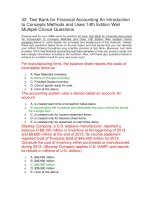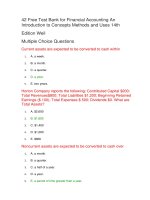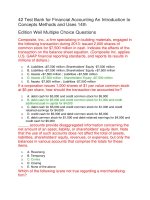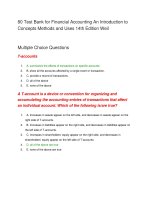Managerial accounting and introduction to concepts methods and user 11e by maher chapter 08
Bạn đang xem bản rút gọn của tài liệu. Xem và tải ngay bản đầy đủ của tài liệu tại đây (517.53 KB, 29 trang )
CHAPTER 8
Capital
Expenditure
Decisions
PowerPoint Presentation by
LuAnn Bean
Professor of Accounting
Florida Institute of Technology
© 2012 Cengage Learning. All Rights Reserved. May
not be copied, scanned, or duplicated, in whole or in
part, except for use as permitted in a license
distributed with a certain product or service or
otherwise on a password-protected website for
classroom use.
Managerial Accounting 11E
Maher/Stickney/Weil
1
☼
CHAPTER GOAL
☼
This chapter explains how the differential
principle applies to long–term decisions where
the focus is on changes in operating capacity
over several future time periods. Present value
analysis, also called discounted cash flow
(DCF), provides analysts with the appropriate
technique.
2
LO 1
CAPITAL
CAPITAL BUDGETING:
BUDGETING:
Definition
Definition
Involves deciding which longterm investments to take
involving capital (long-term)
assets.
3
LO 2
STRATEGIC PLANNING
In
In strategic
strategic planning,
planning, an
an organization
organization
decides
decides on
on major
major programs
programs and
and
the
the resources
resources to
to devote
devote to
to them.
them.
Strategic
Strategic planning
planning provides
provides the
the
context
context for
for capital
capital expenditure
expenditure
decisions.
decisions.
4
LO 2
BENEFITS: Long-Term Investments
Reducing potential to make mistakes improves
product
Making goods, delivering services that competitors
cannot
Reducing cycle time to make product
Permanently reducing costs to provide such an
advantage that competitors cannot afford to enter
market
5
LO 3
DISCOUNTED
DISCOUNTED CASH
CASH FLOW
FLOW
(DCF):
(DCF): Definition
Definition
Aids in evaluating investments
involving cash flows over time
where there is a significant
difference between cash payment
and receipt.
6
LO 3
ELEMENTS OF DISCOUNT RATE
The choice of a discount rate should consider the
following
A pure rate of interest that reflects the productive
capability of capital assets
A risk factor reflecting the riskiness of the project
An increase reflecting inflation expected to occur
over the life of the project.
7
LO 3
RISK-FREE
RISK-FREE RATE:
RATE: Definition
Definition
Is the pure interest rate plus
expected inflation.
8
LO 3
What is the real
interest rate?
The real interest rate is the
pure interest rate plus a
premium for risk but no
increase for inflation.
9
LO 3
NOMINAL
NOMINAL INTEREST
INTEREST RATE:
RATE:
Definition
Definition
Includes all three factors: pure
interest, risk premium, and
expected inflation.
10
LO 3
DECISION RULE
Estimate the amounts of future cash inflows
and future cash outflows in each period for
each alternative
Discount the future cash flows to the present
using the project’s discount rate.
If the present value of future cash
inflows exceeds the present value of
future cash outflows for a proposal,
The firm should accept the project
with the largest NPV.
Reject any negative PV.
11
LO 3
CASH FLOW VARIETIES
Initial cash flows:
Occur at beginning of project
Periodic cash flows
Occur during life of project
Terminal cash flows
Occur at end of project
12
J
E
P
LO 3
EXAMPLE: JEP Realty Syndicators
JEP Reality Syndicators, Inc. (JEP) is considering
acquisition of computer hardware with a 5-year
life. Disposal of current hardware occurs in Year 0
with no gain or loss and no tax consequences.
Cost
$ 100,000
Market value of present equipment
$ 10,000
Scrap value
$
5,000
Continued
13
LO 3
J
E
P
EXHIBIT 8.1
Projected
Projected
cash
cashflows
flows
over
overlife
lifeof
of
project.
project.
14
J
E
P
LO 3
Year 0 & Year 1
EXHIBIT 8.2
Depreciation
Depreciationisis
subtracted
subtractedbefore
before
tax
tax
15
J
E
P
LO 3
Year 0 & Year 1
Pretax
Pretaxnet
netcash
cashinflow
inflow
(outflow)
(outflow)––tax
taxpayable
payable
==Net
Netcash
cashinflow
inflow
(outflow)
(outflow) XXPV
PVfactor
factor
(12%)
(12%)==NPV
NPV
EXHIBIT 8.2
16
LO 3
J
E
P
=
EXHIBIT 8.2
+
+
+
+
+
Projected
Projectedcash
cash
flows
flowsover
overlife
life
of
ofproject
projectisis
positive
positive
$12,469.
$12,469.
>>>ACCEPT
>>>ACCEPT
17
THREE ESTIMATES for
Calculating NPV
LO 4
The calculation of NPV for a proposed project
requires three types of projections
Amount of future cash flows
Timing of future cash flows
Discount rate
Note: errors in predicting amounts of future cash flows will
likely have the largest impact.
18
LO 4
J
E
P
+
+
+
+
==$350,000
$350,000
ininrevenues
revenues
Base case
EXHIBIT 8.3
19
LO 4
J
E
P
+
+
+
+
==$344,000
$344,000
ininrevenues,
revenues,
less
lessthan
than
projected
projected
Amount of future cash flows
EXHIBIT 8.3
20
LO 4
J
E
P
+
+
+
+
==$350,000
$350,000
ininrevenues,
revenues,
not
notreceived
received
as
asexpected.
expected.
Timing of future cash flows
EXHIBIT 8.3
21
LO 4
J
E
P
+
+
+
+
==$350,000
$350,000
ininrevenues,
revenues,
but
butdiscount
discount
rate
ratechanged.
changed.
Discount rate changed to 13%
EXHIBIT 8.3
22
LO 5
DECISION RULE
The decision to accept or reject an investment proposal can be made using
either the internal rate of return method or the net present value method under
most circumstances.
Net Present Value Method
1. Compute the investment’s
net present value, using the
organization’s cost of capital
adjusted for project-specific
risk as the discount rate
(hurdle rate).
2. Undertake the investment
if its net present value is
positive. Reject the
investment if its net present
value is negative.
Internal Rate of Return Method
1. Compute the investment’s
internal rate of return.
2. Undertake the investment if
its internal rate of return is
equal to or greater than the
organization’s cost of capital
adjusted for project-specific risk
(hurdle rate). If not, reject the
investment.
23
LO 5
J
E
P
JEP’s
JEP’s
hurdle
hurdlerate
rate
isis12%.
12%.
Should
Shouldthey
they
accept
acceptthis
this
project?
project?
EXHIBIT 8.4
24
LO 6
JUSTIFYING INVESTMENTS
Investments in computer-integrated manufacturing are
often difficult because of difficulties in applying
discounted cash flow methods
Hurdle rate too high
Should be cost of capital
Bias toward incremental projects
Uncertainty about operating cash flows
Exclusion of benefits that are difficult to quantify
More flexibility
Shorter cycle and lead times
Reduction of non-value-added costs
25









